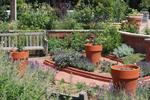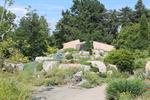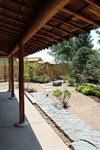
Denver Botanical Gardens
This 60 year old estate on 23 acres displays a range of stunning gardens that can inspire even a unit dweller into aspiring for a better balcony.
Regarded as one of the five top botanic gardens in the USA, this site contains more than 20 distinct gardens and over 15,000 plant species. In addition, it contains a huge Conservatory, a library, a herbarium, and community gardens, to offer more inspiration to visitors.
 The Rock Alpine Garden is world renowned, displaying over 3000 species of plants from over 30 countries with similar high altitudes. Over 500 tons of five different rock types were used to create this garden, which covers just over one acre. It was designed to provide more than a dozen different high altitude climates, and in doing so, is able to accommodate a wide variety of plants. The best time to visit the rock garden is either in March and June (when rockery perennials are at their best). Although beyond the reach for the average gardener, the concept of what can be achieved can be adapted by the home gardener.
The Rock Alpine Garden is world renowned, displaying over 3000 species of plants from over 30 countries with similar high altitudes. Over 500 tons of five different rock types were used to create this garden, which covers just over one acre. It was designed to provide more than a dozen different high altitude climates, and in doing so, is able to accommodate a wide variety of plants. The best time to visit the rock garden is either in March and June (when rockery perennials are at their best). Although beyond the reach for the average gardener, the concept of what can be achieved can be adapted by the home gardener.
The Boettcher Memorial Conservatory contains the only major collection of tropical plants in that part of America. Included is one of the largest collections of palms in the country (over 40 species), many of which are rare in cultivation. Many Australian gardeners may be amused to find palms that grow in their backyards featured as a difficult to grow plant in Denver.
The water gardens are also world famous and contain over 450 different types of water plants. This area is made up of a series of interconnected ponds, falls and streams, both formal and informal in style, and which showcase a wide variety of different water features. The peak water lily display is in August-September. Over winter, these water displays are drained and the plants are stored in a protected environment.
The Japanese Gardens cover around 2 acres, and were designed by Koichi Kawana, a professor of Japanese art and landscape architecture from University of California. Some compromises have been made because of Denver's cold  climate hence some of these species usually associated with a Japanese garden are not used as extensively as might be found elsewhere. Maples and rhododendrons have been used sparingly, whereas pines have been planted in abundance. More than 120 Ponderosa pines were selected and collected by the Denver Bonsai Club from a site in the nearby Rocky Mountains, then moved and pruned to create a spectacular effect.
climate hence some of these species usually associated with a Japanese garden are not used as extensively as might be found elsewhere. Maples and rhododendrons have been used sparingly, whereas pines have been planted in abundance. More than 120 Ponderosa pines were selected and collected by the Denver Bonsai Club from a site in the nearby Rocky Mountains, then moved and pruned to create a spectacular effect.
Other gardens include the Rose garden, Xeriscape (dry) garden, Herb garden, Scripture Garden, Perennial Walk, and Romantic gardens.
For more information go to http://www.botanicgardens.org
Denver Botanic Gardens is located at 1005 York Street, Denver, CO 80206
Phone: 720-865-3500
Fax: 720-865-3713
Want to Learn More
Consider doing a course or buying a reference book from our school.
If you would like to communicate with one of our professional tutors, consider using our free course counselling service. click for details
To browse our courses, go to,,,
Garden History Course go to http://www.acsgarden.com/Courses/garden-history-999.aspx
Garden Design Courses http://www.acsgarden.com/Courses/garden-design-courses.aspx
Tourism and Hospitality Courses http://www.acsedu.co.uk/Courses/Hospitality-Courses.aspx
More from ACS
Ebook - Advice from professional horticulturists with decades in the industry.
View eBook
Ebook - Identify, select, grow, care, propagate, landscape,
dictionary of perennials.
View eBook
Ebook - Introducing and using herbs: cultivation, propagation, pests and diseases, herb gardens, plant directory, herbs in pots - 113 colour photos, 61 pages.
View eBook
Get a great overview of plant taxonomy, and learn to identify over 100 plants as well as many plant families.
View Course
Ebook - Know what you can grow where and how with this accessible text.
View eBook
Very comprehensive - great starting point to your career in horticulture.
View Course
Understanding historical styles of gardens, gives you a wider and more solid range of design options.
View Course